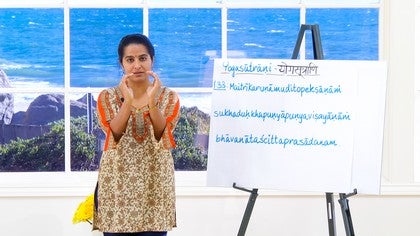Description
About This Video
Transcript
Read Full Transcript
Namaste, Swagatam, I hope you have been enjoying this experience of discovering or rediscovering the yoga sutras with an appreciation of what the Sanskrit looks like as well. So we have already looked at a few sutras, the sutra number 1.2 and 1.3. Let's move on to the next one, 1.33 which is the 33rd sutra of the first chapter. In the practice of yoga, what Patanjali says is chitta vritti nirodha ha is the ability to stop the mind and from its regular movements. He gives a lot of options of how we can achieve that and of those he also describes these particular techniques that can help an individual to calm down and to connect with a deeper self.
So we have these words here, we'll start, maitri karuna mudhito peksha nam sukadu kapunya punya vishayana bhavanata chitta prasada nam. Now that's a really long sutra and the sutra has, as we are seeing here, there are three words but these words have a lot of compound words. There are many smaller words that have been put together to form this long sequence of words here. I had mentioned in a previous session that one of the features of Sanskrit is the way it makes compound words, that the words come together and you have a whole idea represented in a single word. So in Sanskrit the challenge sometimes is that we not only see these words relating to different ideas that come together but we also then combine the phonetic words or rather we have phonetic combinations that are known as the euphonic combinations or the sandhi and that sometimes makes the word even longer.
So we do have instances of a whole word running throughout almost half a page or even one page. So it's in that context that the study of Sanskrit gives scope to go deeper and not just stop at what we are discovering here but stay with me and I assure you we'll take this step by step so that you don't feel lost and we can achieve a degree of independence with this language to give us enough content or enough knowledge to be able to use it in a more confident manner. So let's look at what we have in front of us here. We have maitri karuna mudito peksha nam. Let's try to write that out.
So we have first mai. So it's a combination of the consonant m along with the vowel ai. I will mark out the vowels or the symbols of the vowels in a different color so that you start recognizing how the symbols of the vowels combine with the consonants. So that's mai and then we have three. So that three is a combination of tr which we saw was a conjunct consonant or already a composite letter and that was represented like that.
Since it's a long e we know that it will follow the letter and there is a hook from the head of that letter to that stick. If it was a short one then we would have had to put the stick before but since it's long it will follow. So mai three and then kar. It's a simple vowel a so there is no extra symbol kar and then we have ru. I had also mentioned in my previous section that the consonant r combines a little differently with vowels as well as with consonants.
So just pay attention when you come to the sound r. In this case it is ru and it just has a line like that ru just emphasize it a bit. So that's the ru and then we have the na which is as the dot appears below. It represents the cerebral na that's that and then we add the vowel a which is that extra line by the side. Then we have the mu and that's where you can start learning.
So we have the mu with the i looks like that. We have the mu again so write the full mu and then it's a short u so it comes below the letter mu and then we have the d which doesn't have any dot below it so it is the dental d and that is the but there is a e that follows which is a short vowel and therefore it will have to have a stick before the letter. Put the letter sometimes if you forget it it doesn't matter. I mean you can always leave enough spacing as you're writing the words so that in case you have left something out you can still come back with a line or something to add it in. Okay so mu d and then you have the to again there is no dot below so it would be a dental soft sound.
So we have to and then we have the vowel o so the toe is an extra stick with an antenna toe and then we have the pay here so the letter per and the vowel a which is just an antenna on it. So here you can notice the difference when it is an o there is an extra stick with the antenna on it if it is an a it is a direct antenna on the letter itself. And then we have the combination ksha is the letter the different letter it's a very very beautiful letter to write out there's a very beautiful flow ksha and then the vowel a so it becomes like that on the side and then we have again the na it's a cerebral n because of the dot below it na and the vowel a followed by the m but as you notice the m has a dot on top so the dot on top is represented by the anuswara or the dot on top of the word on the top of the letters. So here we have maitrikaruna, muditope, shanam there you go. What is important to remember when you are writing out the Sanskrit letters is that there is a there is a kind of a proportion in the letters there is a natural concept of the proportion of the letters as well as the distance between the letters.
We have that in all languages I mean it's not unique to the Sanskrit script I must say but in order to help yourself to write aesthetically as beautifully as you can it might be a good idea to try and use you know a sheet which has lines so that you try and get the letters of an equal proportion. I have not done it too well here but that would be a helpful place to start. So we have looked at maitrikaruna, muditope, shanam the next series is the sukha. So we have s and u because there is no dot under it will be the dental suh and with the vowel u there we are and then the kha is a combination of the ur so there is no extra symbol on this sorry I am rewriting it just to try and make sure that you can see it properly there sukha and then we have duh kha so duh since there is no dot below it will be the dental sound duh and the vowel u below that u so just like suh kha duh same thing and then you have the aspirite ha which can be represented like this or rather I should make it with the red so just imagine it is a red because it forms part of the vowels okay color it up yeah it is very fat but so duh and then kha again we have seen it before so kha then we have poo so we have the purr we have seen the purr there so now we see the purr again and we have seen the u so we know how to add that below the letter poo that's it and then we have a combination of the nasal na the cerebral nasal na with the year so that's interesting so the na as you can see here is in the complete form has this extra t with it so when it comes in combination with another consonant you drop that thing and write the year so punya we have the vowel a so you have to add that extra line beside it punya and then we have again poo so it becomes purr longer and the vowel u and then again so we repeat that nya but you can see it's a short a so there is no extra symbol as we did here so punya then we have v it's the short e so the line has to come before and have the hook so keep that in mind and already place the e and then write the v and place the hook on top v sometimes what can tend to happen is if you're not paying attention fully you can tend to forget the hook in which case you would have punya which is a completely different word so the writing of Sanskrit also requires you to pay a lot of attention and be in the present which is a sadhana in itself which is a yogic practice in itself so we have next the sh with the dot below so it's the cerebral one and then we have the yaa so we saw the letter yaa and the yaa combination already put that in there yaa and we have already seen the nam in that section so the same thing again so we have the na na and the aaa and we have the dot on top there we go so this is su kha do no line on top of that kha punya punya punya and then vishya yaa nam so we do that once su kha do kha punya punya vishya yaa nam you need to make sure you take a long breath before you say that one which is good so we move on to the next word which is bhava naat or rather bhava na tah and this is how it's written so we have the bha which is the bha with the vowel aaa there we go bha and then we have the vuh that we have seen before but because it's with the vowel aaa you don't add any symbol to it and then you have the dental nerve so the dental nerve was written like that we have the vowel aaa so you add an extra stick to that then we have a tah which was something that we have seen here already but there it was with a vowel o here it is a simple one so it will just be that and then we had seen that with the first sutra of yoga chitta what I'll do here is I'll give you a slight variation so in that one we had seen it written in a particular manner because of the e that follows you have to put the stick in first and then the sha as we have seen can also be written like the two with a small stick on the head so we'll I will show this to you so that when you see it you know that there is this variation that is possible and then the chha the e that will go from this head to that and then we have the double tah again so we've seen this word before it's the chitta we've also seen the prra with pranayama so the prra is the purr and I will mark that in the different color so that you know that and I'll mark it with the r there so you know that that's the connection okay so prra and then sa so it's the sa ah so the full sa and with the symbol ah then we have the the which is the dental the the dental nah and now at the end we have the mmm we'll put that together so we have bah remember not to put the line over the bah because we have the mer there or the mer there where the line goes all the way across so if you put that line across it can be confusing or you'll have another letter so bah na tash chitta prra sa the numb you'll also notice that to I'm trying to keep the combination of the diacritical with the devanagari representation but as a result I'm having to also stretch it out a little bit so if you visualize it if you had to just write it in the Sanskrit it could actually be much shorter the amount of space used is much less because of these possible combinations that form so the other point is that here we have the mmm with the dot and it's this it has the same function as the mmm with the line across when the nasal n comes at the end of the word it or at the end of the sentence it would normally be represented like that in the middle of the sentence depending on what letter follows it it will either become a dot or it'll become the letter ma that's a little more of a specification but we can learn about that as and when we learn more about the language so here we are let's try to say that okay so first time we'll say that by looking at the transliteration you're with me. I am purposely saying the vowels a little longer and slower so that you get tapunya vishaya nam bhavana taschitta prasada nam great now let's see the devanagari maitri karuna mudi topi kshanaam sukadu kapunya punya vishaya nam bhavana taschitta prasada nam so if you want to help yourself you can further just sort of put it together then you know it goes together so you can do bhavana if you feel that that helps you okay or astu I'd like to introduce this other word astu which means so be it so astu astu now we have just seen the words we have seen what it looks like but since you're already familiar a little with the yoga tradition you know that there are many other smaller words within the single word that you see so we have maitri which means friendliness practice of friendliness towards others karuna or compassion towards the needy towards the sad mudita the original word is mudita which means sympathetic joy or sometimes also translated as gladness but you would see the mismatch I'm saying mudita and what we have there is mudito so that is because again the euphonic combination of a and u so if you say a and u really fast ah wah wah wah wah wah wah it'll end up becoming an o okay so mudita upeksha nam upeksha is equanimity or neutrality and sometimes also translated as indifference but it mainly has a sense of the neutrality let's say and upeksha nam you must be wondering what this nam is doing there but that would go into the grammar part of it which has a beautiful philosophy and I sincerely hope that you'll stay with me and when we come to that I'll share it with you but it means of these qualities basically so we move on suka happiness or delight it's a fantastic word again but we'll keep that for another time dukha sorrow or sadness punya punya can be understood as virtue apunya so again you will wonder why I'm saying punya and apunya when you just sing one vowel there we get back to the idea of the sandhi where you have punya apunya you say that fast and it will become punya punya yeah so punya punya apunya being vice or wicked and then we have vishaya nam of these objects again the nam is of these objects in that sense and then bhavanata chitta as we saw with yoga chitta vritti nirodha with yoga chitta if you slow it down it will become yoga chitta and that's the phenomenon that's happening here so bhavanata chitta prasada nam it comes prasada is the pleasing or the joyfulness of the spirit of the mind of the being okay I will just write it out for your convenience again that this is a combination of a and a and this here is a combination of a plus chi okay I'm playing around a little bit there but I think if you are following me you will understand what has been written there yeah so there we go would you like to just say that once we'll just say it once reading the whole thing together yeah my three karuna moody topa ksha nam sukha dukha punya punya vishaya nam bhavanata chitta prasada nam take a deep breath allow the sounds of what you have said to settle in your being not just to settle in your being you can be sure that if you've pronounced it the way it is said to be pronounced or the way it is meant to be pronounced the sounds will start having their own movement and transformative action in yourself so enjoy study Sanskrit practice nothing can be achieved without practice abhyasa astu punar milama







You need to be a subscriber to post a comment.
Please Log In or Create an Account to start your free trial.